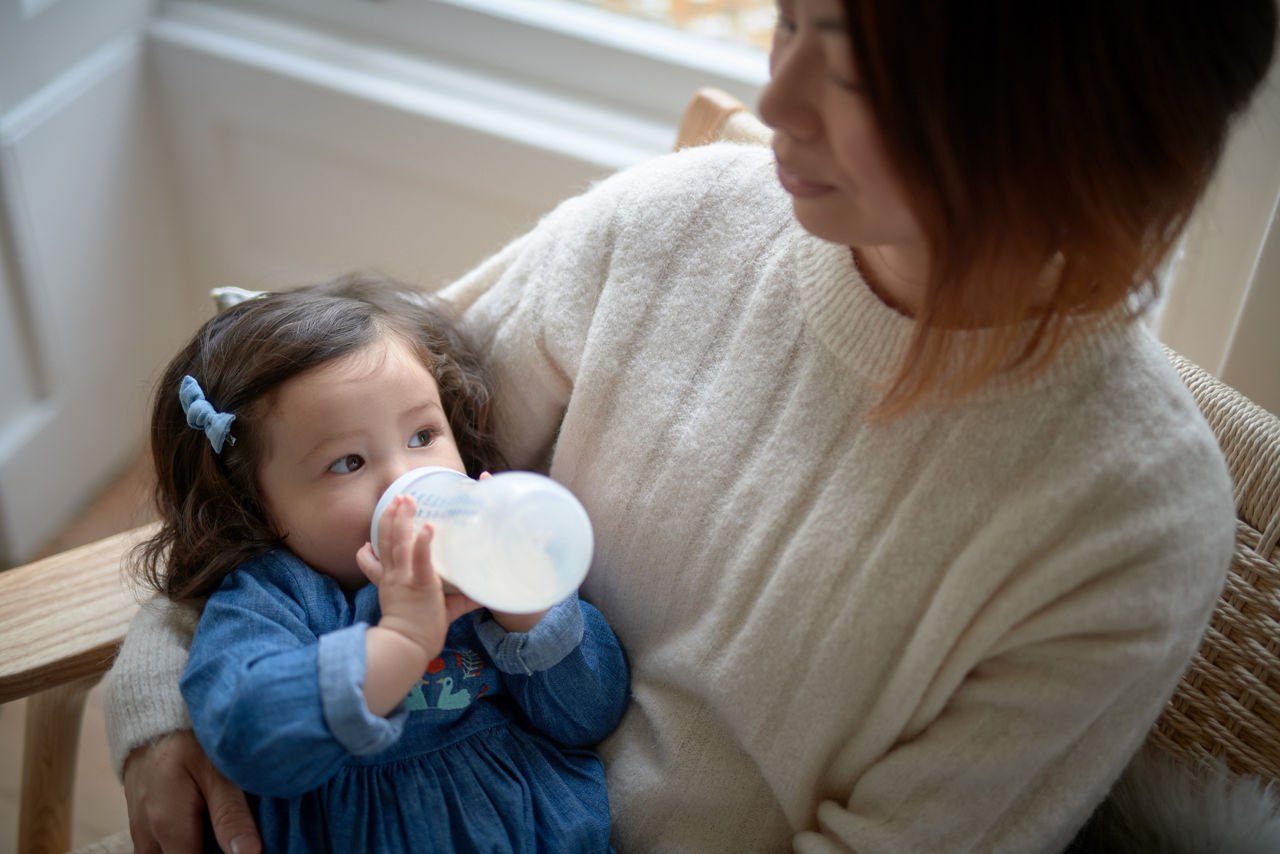Correct and safe preparation is critical when making up a bottlefeed.
Breastmilk provides a baby with perfectly balanced nutrition, which is why both the Department of Health (DH) and the World Health Organisation (WHO) recommend exclusive breastfeeding for the first six months of a baby’s life and continued breastfeeding alongside the introduction of appropriate solid foods beyond six months1,2.
Some mums choose not to or can not breastfeed. In this instance, infant formula milks provide the only alternative to breastmilk. The Department of Health recommends that cows’ milk should not be introduced as a main drink before 12 months of age3.To support the changing nutritional needs of infants and toddlers throughout the different stages of their development, there are different formula milks available.
- FIRST INFANT MILKS (STAGE 1) is a nutritionally tailored formula suitable from birth onwards if mum is combination feeding or exclusively bottle feeding.
- FOLLOW ON MILKS (STAGE 2) are nutritionally tailored to complement a weaning diet for formula fed babies from 6-12 months of age.
- GROWING UP MILKS (STAGES 3 & 4) have been specifically fortified with nutrients to support toddlers’ increased nutritional needs, such as iron to support normal cognitive development.
- SPECIALIST MILKS are specifically tailored to the differing needs some babies may have including common feeding issues such as reflux, colic and constipation, as well as cow’s milk allergy (CMA) and provide all the nutritional requirements the babies need.
Guide to making up a bottlefeed
Feeds need to be prepared when required, as storing or freezing formula milk is not recommended. It’s always best to follow the instructions on-pack. Please note these instructions are for powdered milks only. Preparation instructions for specialist milks will vary. For follow-on milks and growing up milks: If you are bottle-feeding, the Department of Health advises to introduce a cup or beaker from about six months4.
- Wash and sterilise bottles and teats according to manufacturer’s instructions. Wash your hands and wipe clean all surfaces to prevent the spread of germs.
- Boil 1 litre of freshly run tap water and leave to cool for no longer than 30 minutes, unless otherwise indicated on pack. Measure required amount of water (refer to on-pack instructions) into a sterilised bottle. Do not use artificially softened or repeatedly boiled water.
- For accurate dosage, always use scoop provided and level off powder with built-in leveller (if provided). Alternatively, level with a clean, dry knife. Do not press extra powder into scoop.
- Add the correct measure of powder to the water. Adding too many or too few scoops can be harmful. Place the sterilised teat and cap on the bottle and shake immediately, vertically and vigorously for at least 10 seconds, until the powder is dissolved.
- If necessary, cool feed under running water. Remove cap and test temperature of milk by allowing some drops to fall on your wrist. If it feels comfortable, it should be just right for the baby. Do not heat feeds in a microwave as hot spots can occur and cause scalding.
You can download our guide on how to prepare a bottle correctly.
Must follow
- Manufacturers instructions vary – follow instructions on pack carefully
- Always put the water in the bottle first, while it is still hot, before adding the powdered formula
- Make sure you only use the scoop that comes with the powdered formula
- Do not add anything else to the feed in the bottle
- Remember to let the feed cool before giving to your baby – by holding under cold running water or placing in cold water bath
- Never warm up formula in a microwave
- Use made-up feeds within two hours. Once used, discard any leftover milk, wash bottles and teats, and re-sterilise, ready for next feed
- The World Health Organization’s infant feeding recommendation [online]. Available at:http://www.who.int/nutrition/topics/infantfeeding_recommendation/en/ [Accessed October 2019].
- Department of Health. Infant Feeding Recommendation [online]. 2003. Available at: https://webarchive.nationalarchives.gov.uk/20120503221049/http://www.dh.gov.uk/en/Publicationsandstatistics/Publications/PublicationsPolicyAndGuidance/DH_4097197 [Accessed October 2019].
- Scientific Advisory Committee on Nutrition (SACN). Feeding in the First Year of Life [online]. 2018. Available at: https://assets.publishing.service.gov.uk/government/uploads/system/upload
- Department of Health. Diet and Nutrition Survey of Infants and Young Children [online]. 2011. Available at: https://assets.publishing.service.gov.uk/government/uploads/system/uploads/attachment_data/file/139571/DNSIYC_Executive_Summary_UK__updated_.pdf [Accessed October 2019].

